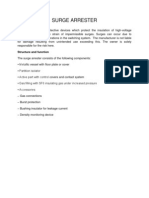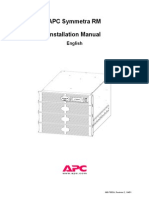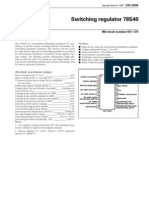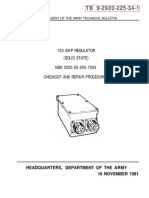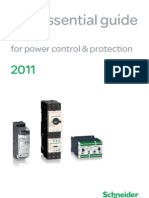Professional Documents
Culture Documents
Study and Solution of Reactive Power Compensation, Harmonics Mitigation and Load Balancing For Power Factor Improvement of Jaipur Metro Power Supply System Using Active Harmonic Filters
Uploaded by
Anonymous izrFWiQOriginal Title
Copyright
Available Formats
Share this document
Did you find this document useful?
Is this content inappropriate?
Report this DocumentCopyright:
Available Formats
Study and Solution of Reactive Power Compensation, Harmonics Mitigation and Load Balancing For Power Factor Improvement of Jaipur Metro Power Supply System Using Active Harmonic Filters
Uploaded by
Anonymous izrFWiQCopyright:
Available Formats
Volume 4, Issue 7, July – 2019 International Journal of Innovative Science and Research Technology
ISSN No:-2456-2165
Study and Solution of Reactive Power Compensation,
Harmonics Mitigation and Load Balancing for Power
Factor improvement of Jaipur Metro Power Supply
System using Active Harmonic Filters
Bharat Lal Mali Dr. Pramod Sharma
M. Tech. Scholar, Professor,
Regional College for Education Research and Technology Regional College for Education Research and Technology
Sitapura, Jaipur Sitapura, Jaipur
Abstract:- This paper presents a study and solution of improve the true power factor is our main concern. The PF
different power quality issues of Jaipur Metro Rail is given as:
Corporation (JMRC) power supply system. The
measurement of different parameters was taken at KW
132kv incoming feeder of Jaipur Metro Receiving Sub PowerFactor
Station. The measured data were analyzed and different KVA (1)
power quality issues like excess reactive power; current
harmonics and load unbalancing were observed. These B. Displacement Power Factor (Cos ):
power quality issues makes power factor poor. A The Displacement power factor is the Cosine of angle
solution of these power quality issues using Active between fundamental voltage and fundamental current
Harmonics Filter has been proposed. waveforms. Thus simply the Displacement Power Factor is
Cos of fundamental wave. Thus Displacement Power
Keywords:- Power Quality, Harmonics, Load unbalancing, Factor is remains unaffected from voltage and current
Reactive Power, Power Factor, Active Harmonics filter, harmonics and is always greater than or equal to true Power
Non Linear Loads, Total harmonics Distortion (THD). factor.
I. INTRODUCTION C. Distortion Power Factor (DPF):
The distortion power factor term is introduced by the
The Metro Railway network is increasing rapidly in harmonics. The distortion power factor is given by:
India. The Metro Railways power supply system consist
large cabling network which causes problem of excess
1
reactive power. The metro railway loads are nonlinear and DPF (2)
unbalanced due to single phase traction load which causes (1 iTHD 2 )
generation of harmonics and load unbalancing. Thus metro
railways power supply system suffers with power quality
The True Power factor in terms of Displacement
issues like excess reactive power flow, harmonics and load
Power factor and Distortion Power factor is given by:
unbalancing etc. These power quality issues makes power
factor poor.
PF (True) Cos DPF (3)
II. POWER FACTOR
The factors affecting the power factor are as under:
Power Factor is the ratio of Useful Power (kW) to
Apparent Power (kVA). The value of PF should be Reactive Power
maintained at unity for reduced losses and optimum Harmonics
capacity utilization. The power Factors further can be Load Unbalance
classified as under [1], [2]:
Reactive Power
A. True Power Factor (PF) The relation of Active Power, Reactive Power and
The True Power factor is the ratio of Active Power to Apparent Power can be understood by Power triangle given
the Apparent Power which is containing effect of voltage below:
and current harmonics and load unbalance also. The
presence of Voltage and Current harmonics makes the true
power factor poor and is always less than Displacement
Power Factor (Cos ). The power supply utilities apply PF
penalties/rebates on true power factor. Therefore to
IJISRT19JUL125 www.ijisrt.com 1060
Volume 4, Issue 7, July – 2019 International Journal of Innovative Science and Research Technology
ISSN No:-2456-2165
III. SOLUTION OF POWER FACTOR
IMPROVEMENT
The power factor of any system having power quality
issues like reactive power flow, Harmonics distortion, load
unbalancing and neutral current can be improved by Active
power filter only. The Active Power filter is capable to fix
all kind of power quality issues as discussed above.
A. Active Power Filter
The Active Power Filter’s (APF) are voltage source
converter based device which do not uses any passive
elements for generation of reactive power. The Shunt APF
is used for the harmonic currents, load balancing and
reactive power compensation. Shunt APF consists of a
Fig 1:- Power Triangle three phase VSI with a capacitor which acts as a voltage
controlled current source [7], [8].
From the Power triangle, the Apparent Power is given
by: IV. JMRC SUPPLY SYSTEM
2 JMRC receives power supply at 132KV at its
P Q
2 2
S Receiving Sub Station (RSS). JMRC have two RSS namely
(4) Mansarovar (MSOR) and Sindhicamp (SICP). 132KV
supply is step down to 33KV, 3-Phase to feed auxiliary
Thus from equation (1) and (4) it can be concluded load of all metro stations and 25KV single phase to feed
that Power factor is further depend on flow of Reactive traction load for train operation. An overview of complete
Power. If the generation Reactive Power is equal to JMRC supply system has shown in fig. 2.
consumption of Reactive Power i.e. there is no reactive
power flow in the network, then the system Power Factor
will be unity.
Harmonics
Harmonics are sinusoidal voltages or currents having
frequencies that are multiples of the fundamental frequency
at which the supply system is designed to operate. The
harmonic currents generated by the load or more accurately
converted by the load from fundamental to harmonic
current have to flow around the circuit via the source
impedance and all other parallel paths. As a result, Fig 2:- JMRC Supply System Overview
harmonic voltages appear across the supply impedance and
are present throughout the installation [3], [4]. V. MEASUREMENTS
Load Unbalancing The measurement of different parameters was taken
Unbalance in a 3 Phase system is marked by a using power quality analyzer at 132KV incomers of both
difference in the magnitude of current/voltage in different RSS of JMRC. The graphs of measured parameters have
phases or when the phase separation is not 120 degrees. A given in fig. 3, 4, 5, 6 respectively.
balanced three-phase AC system acts like three independent
single-phase systems. There’s no neutral current, and the
total active and reactive powers are just the arithmetic sum
of the active and reactive phase powers. When there is any
phase unbalance or harmonics, this classical (arithmetic)
approach doesn’t hold for apparent power. We need either
IEEE 1459 or the Unified Power Measurement (UPM)
method to calculate it. If the real power differs substantially
from apparent power, the true power factor gets poor [5],
[6].
Fig 3:- Measurement of Power
IJISRT19JUL125 www.ijisrt.com 1061
Volume 4, Issue 7, July – 2019 International Journal of Innovative Science and Research Technology
ISSN No:-2456-2165
S.N. Parameter MSOR SICP
1 Active Power (MW) 3 2
2 Reactive Power (MVAR) -2.7 -1.7
3 Apparent Power (MVA) 4.5 3
3 Power Factor 0.33 0.4
4 Cosϕ 0.37 0.45
5 iTHD (%) 10 12
Fig 4:- Measurement of PF & DPF
6 Load Unbalance (%) 14 10
Table 1:- Measurement Summary
B. AHF Rating calculation
Based on the measurement summary, the AHF rating
for mitigation of different power quality issues can be
calculated as:
For Reactive Power Compensation
The AHF current rating for Reactive Power
compensation can be calculated as under:
Reactive Power (Q)
A (AHF) (3)
3 AHF Voltage
Fig 5:- Measurement of Harmonics
Where Q is the required reactive power to be
compensated and V is AHF voltage.
For Harmonics Mitigation
Thus AHF current rating for harmonics mitigation at
415 voltages can be calculated as:
Current THDi Voltage
A(AHF) (4)
AHF Voltage 100
For Load Balancing
I(-) Voltage
A (AHF)
AHF Voltage (5)
Fig 6:- Measurement of I (-) Based on the calculation of AHF ratings (A) as per
equations (3), (4) and (5), the ratings of AHF have given in
A. Measurement Summary table 2.
Based on the measurement of Power, Power Factor,
Harmonics and load unbalancing as shown in fig. 3, 4, 5
and 6 the measurement summary of different parameters For For I
S.N. RSS For Q Total
has shown in below table: iTHD (-)
1 MSOR 4174 890 4451 9515
2 SICP 2782 762 3186 6731
3 Both 6956 1653 7637 16246
Table 2:- AHF Rating
IJISRT19JUL125 www.ijisrt.com 1062
Volume 4, Issue 7, July – 2019 International Journal of Innovative Science and Research Technology
ISSN No:-2456-2165
C. Proposed Scheme
Based on the AHF rating calculation, the proposed scheme of power factor improvement with location of Active Harmonic
filter (AHF) has shown in fig. 7.
Fig 7:- Proposed Scheme
VI. CONCLUSION Improvement in a Nonlinear Loaded Electrical
Installation,” RE&PQJ, Vol. 1, No.1, April 2003.
From the study of a typical metro supply system for [4]. Sourabh Gupta, Preeti Gupta, “Harmonics Mitigation
power quality improvement by Active Power Filter, the Using Active Power Filter,” International Journal of
following conclusions are drawn:- Advanced Computer Research (ISSN (print):2249-
7277 ISSN (online):2277-7970) Volume-3 Number-2
Most of the loads connected to the system are non- Issue-10 June-2013.
linear which generates harmonics in the system. [5]. Zakir Husain, Ravinder Kumar Singh and Shri Niwas
The single phase traction load causes load unbalancing. Tiwari, “Balancing of Unbalanced Load and Power
The use of cabling network causes generation of excess Factor Correction in Multi-phase (4-phase) Load
reactive power which causes power factor poor Circuits using DSTATCOM,” Proceedings of the
(leading). World Congress on Engineering 2010 Vol II.WCE
The JMRC load is dynamic in nature due to traction 2010, June 30 - July 2, 2010, London, U.K.
load. Therefore only dynamic compensation i.e. Active [6]. DENISA RUSINARU, LEONARDO-GEO
Power Filter can be used for Power Factor MANESCU, MARIUS MERFU, “The Load
Improvement. Unbalance Influence on the Power Factor Value in
Therefore to mitigate these all power quality issues Three-Phase Distribution Networks,” Recent
which are causing power factor poor, Active Power Researches in Electric Power and Energy Systems
Filter has been proposed at load level at 415V. ISBN: 978-960-474-328-5.
[7]. Randeep Singh Chib, Mehak Sharma, Hartaj Singh,
REFERENCES “Active filter and reactive compensation using
DSTATCOM” Randeep et al, Journal of Engineering
[1]. P. Salmerón, J. R. Vázquez, R. S. Herrera and S. P. Research and Studies E-ISSN0976-7916, J Engg Res
Litrán, “Apparent power and power factor in Studies /IV/IV/Oct.-Dec., 2013/10-15.
unbalanced and distorted systems. Applications in [8]. Arun Shankar V.K., Senthil Kumar N.,
three phase load compensations” RE&PQJ, Vol. 1, “Implementation of Shunt Active Filter for Harmonic
No.5, March 2007. Compensation in a 3 Phase 3 Wire Distribution
[2]. Pragya Patel, Dharmendra Kumar Singh, “Evaluating Network,” 1st International Conference on Power
Power Factor and Thd of Power Supply using Various Engineering, Computing and CONtrol, PECCON-
Correction Circuits and Filters,” International Journal 2017, 2-4 March 2017, VIT University, Chennai
of Engineering Research & Technology (IJERT) Campus.
ISSN: 2278-0181Vol. 3 Issue 12, December-2014.
[3]. António P. Martins, “The Use of an Active Power
Filter for Harmonic Elimination and Power Quality
IJISRT19JUL125 www.ijisrt.com 1063
You might also like
- The Subtle Art of Not Giving a F*ck: A Counterintuitive Approach to Living a Good LifeFrom EverandThe Subtle Art of Not Giving a F*ck: A Counterintuitive Approach to Living a Good LifeRating: 4 out of 5 stars4/5 (5794)
- Shoe Dog: A Memoir by the Creator of NikeFrom EverandShoe Dog: A Memoir by the Creator of NikeRating: 4.5 out of 5 stars4.5/5 (537)
- Analysis of Ancol Beach Object Development Using Business Model Canvas ApproachDocument8 pagesAnalysis of Ancol Beach Object Development Using Business Model Canvas ApproachAnonymous izrFWiQNo ratings yet
- Investigations On BTTT As Qualitative Tool For Identification of Different Brands of Groundnut Oils Available in Markets of IndiaDocument5 pagesInvestigations On BTTT As Qualitative Tool For Identification of Different Brands of Groundnut Oils Available in Markets of IndiaAnonymous izrFWiQNo ratings yet
- Design and Analysis of Humanitarian Aid Delivery RC AircraftDocument6 pagesDesign and Analysis of Humanitarian Aid Delivery RC AircraftAnonymous izrFWiQNo ratings yet
- Evaluation of Assessing The Purity of Sesame Oil Available in Markets of India Using Bellier Turbidity Temperature Test (BTTT)Document4 pagesEvaluation of Assessing The Purity of Sesame Oil Available in Markets of India Using Bellier Turbidity Temperature Test (BTTT)Anonymous izrFWiQNo ratings yet
- Teacher Leaders' Experience in The Shared Leadership ModelDocument4 pagesTeacher Leaders' Experience in The Shared Leadership ModelAnonymous izrFWiQNo ratings yet
- Incidence of Temporary Threshold Shift After MRI (Head and Neck) in Tertiary Care CentreDocument4 pagesIncidence of Temporary Threshold Shift After MRI (Head and Neck) in Tertiary Care CentreAnonymous izrFWiQNo ratings yet
- Bioadhesive Inserts of Prednisolone Acetate For Postoperative Management of Cataract - Development and EvaluationDocument8 pagesBioadhesive Inserts of Prednisolone Acetate For Postoperative Management of Cataract - Development and EvaluationAnonymous izrFWiQNo ratings yet
- Platelet-Rich Plasma in Orthodontics - A ReviewDocument6 pagesPlatelet-Rich Plasma in Orthodontics - A ReviewAnonymous izrFWiQNo ratings yet
- Child Rights Violation and Mechanism For Protection of Children Rights in Southern Africa: A Perspective of Central, Eastern and Luapula Provinces of ZambiaDocument13 pagesChild Rights Violation and Mechanism For Protection of Children Rights in Southern Africa: A Perspective of Central, Eastern and Luapula Provinces of ZambiaAnonymous izrFWiQNo ratings yet
- Experimental Investigation On Performance of Pre-Mixed Charge Compression Ignition EngineDocument5 pagesExperimental Investigation On Performance of Pre-Mixed Charge Compression Ignition EngineAnonymous izrFWiQNo ratings yet
- IJISRT19AUG928Document6 pagesIJISRT19AUG928Anonymous izrFWiQNo ratings yet
- Women in The Civil Service: Performance, Leadership and EqualityDocument4 pagesWomen in The Civil Service: Performance, Leadership and EqualityAnonymous izrFWiQNo ratings yet
- Securitization of Government School Building by PPP ModelDocument8 pagesSecuritization of Government School Building by PPP ModelAnonymous izrFWiQNo ratings yet
- Closure of Midline Diastema by Multidisciplinary Approach - A Case ReportDocument5 pagesClosure of Midline Diastema by Multidisciplinary Approach - A Case ReportAnonymous izrFWiQNo ratings yet
- Application of Analytical Hierarchy Process Method On The Selection Process of Fresh Fruit Bunch Palm Oil SupplierDocument12 pagesApplication of Analytical Hierarchy Process Method On The Selection Process of Fresh Fruit Bunch Palm Oil SupplierAnonymous izrFWiQNo ratings yet
- IJISRT19AUG928Document6 pagesIJISRT19AUG928Anonymous izrFWiQNo ratings yet
- Knowledge and Utilisation of Various Schemes of RCH Program Among Antenatal Women and Mothers Having Less Than Five Child in A Semi-Urban Township of ChennaiDocument5 pagesKnowledge and Utilisation of Various Schemes of RCH Program Among Antenatal Women and Mothers Having Less Than Five Child in A Semi-Urban Township of ChennaiAnonymous izrFWiQNo ratings yet
- Enhanced Opinion Mining Approach For Product ReviewsDocument4 pagesEnhanced Opinion Mining Approach For Product ReviewsAnonymous izrFWiQNo ratings yet
- Comparison of Continuum Constitutive Hyperelastic Models Based On Exponential FormsDocument8 pagesComparison of Continuum Constitutive Hyperelastic Models Based On Exponential FormsAnonymous izrFWiQNo ratings yet
- A Wave Energy Generation Device Using Impact Force of A Breaking Wave Based Purely On Gear CompoundingDocument8 pagesA Wave Energy Generation Device Using Impact Force of A Breaking Wave Based Purely On Gear CompoundingAnonymous izrFWiQNo ratings yet
- Risk Assessment: A Mandatory Evaluation and Analysis of Periodontal Tissue in General Population - A SurveyDocument7 pagesRisk Assessment: A Mandatory Evaluation and Analysis of Periodontal Tissue in General Population - A SurveyAnonymous izrFWiQNo ratings yet
- Exam Anxiety in Professional Medical StudentsDocument5 pagesExam Anxiety in Professional Medical StudentsAnonymous izrFWiQ100% (1)
- Assessment of Health-Care Expenditure For Health Insurance Among Teaching Faculty of A Private UniversityDocument7 pagesAssessment of Health-Care Expenditure For Health Insurance Among Teaching Faculty of A Private UniversityAnonymous izrFWiQNo ratings yet
- Pharmaceutical Waste Management in Private Pharmacies of Kaski District, NepalDocument23 pagesPharmaceutical Waste Management in Private Pharmacies of Kaski District, NepalAnonymous izrFWiQNo ratings yet
- Effect Commitment, Motivation, Work Environment On Performance EmployeesDocument8 pagesEffect Commitment, Motivation, Work Environment On Performance EmployeesAnonymous izrFWiQNo ratings yet
- Trade Liberalization and Total Factor Productivity of Indian Capital Goods IndustriesDocument4 pagesTrade Liberalization and Total Factor Productivity of Indian Capital Goods IndustriesAnonymous izrFWiQNo ratings yet
- SWOT Analysis and Development of Culture-Based Accounting Curriculum ModelDocument11 pagesSWOT Analysis and Development of Culture-Based Accounting Curriculum ModelAnonymous izrFWiQNo ratings yet
- The Influence of Benefits of Coastal Tourism Destination On Community Participation With Transformational Leadership ModerationDocument9 pagesThe Influence of Benefits of Coastal Tourism Destination On Community Participation With Transformational Leadership ModerationAnonymous izrFWiQNo ratings yet
- Revived Article On Alternative Therapy For CancerDocument3 pagesRevived Article On Alternative Therapy For CancerAnonymous izrFWiQNo ratings yet
- To Estimate The Prevalence of Sleep Deprivation and To Assess The Awareness & Attitude Towards Related Health Problems Among Medical Students in Saveetha Medical CollegeDocument4 pagesTo Estimate The Prevalence of Sleep Deprivation and To Assess The Awareness & Attitude Towards Related Health Problems Among Medical Students in Saveetha Medical CollegeAnonymous izrFWiQNo ratings yet
- The Little Book of Hygge: Danish Secrets to Happy LivingFrom EverandThe Little Book of Hygge: Danish Secrets to Happy LivingRating: 3.5 out of 5 stars3.5/5 (399)
- The Yellow House: A Memoir (2019 National Book Award Winner)From EverandThe Yellow House: A Memoir (2019 National Book Award Winner)Rating: 4 out of 5 stars4/5 (98)
- Never Split the Difference: Negotiating As If Your Life Depended On ItFrom EverandNever Split the Difference: Negotiating As If Your Life Depended On ItRating: 4.5 out of 5 stars4.5/5 (838)
- Elon Musk: Tesla, SpaceX, and the Quest for a Fantastic FutureFrom EverandElon Musk: Tesla, SpaceX, and the Quest for a Fantastic FutureRating: 4.5 out of 5 stars4.5/5 (474)
- A Heartbreaking Work Of Staggering Genius: A Memoir Based on a True StoryFrom EverandA Heartbreaking Work Of Staggering Genius: A Memoir Based on a True StoryRating: 3.5 out of 5 stars3.5/5 (231)
- Hidden Figures: The American Dream and the Untold Story of the Black Women Mathematicians Who Helped Win the Space RaceFrom EverandHidden Figures: The American Dream and the Untold Story of the Black Women Mathematicians Who Helped Win the Space RaceRating: 4 out of 5 stars4/5 (894)
- On Fire: The (Burning) Case for a Green New DealFrom EverandOn Fire: The (Burning) Case for a Green New DealRating: 4 out of 5 stars4/5 (73)
- The Hard Thing About Hard Things: Building a Business When There Are No Easy AnswersFrom EverandThe Hard Thing About Hard Things: Building a Business When There Are No Easy AnswersRating: 4.5 out of 5 stars4.5/5 (344)
- The Emperor of All Maladies: A Biography of CancerFrom EverandThe Emperor of All Maladies: A Biography of CancerRating: 4.5 out of 5 stars4.5/5 (271)
- Grit: The Power of Passion and PerseveranceFrom EverandGrit: The Power of Passion and PerseveranceRating: 4 out of 5 stars4/5 (587)
- The World Is Flat 3.0: A Brief History of the Twenty-first CenturyFrom EverandThe World Is Flat 3.0: A Brief History of the Twenty-first CenturyRating: 3.5 out of 5 stars3.5/5 (2219)
- Devil in the Grove: Thurgood Marshall, the Groveland Boys, and the Dawn of a New AmericaFrom EverandDevil in the Grove: Thurgood Marshall, the Groveland Boys, and the Dawn of a New AmericaRating: 4.5 out of 5 stars4.5/5 (266)
- Team of Rivals: The Political Genius of Abraham LincolnFrom EverandTeam of Rivals: The Political Genius of Abraham LincolnRating: 4.5 out of 5 stars4.5/5 (234)
- The Unwinding: An Inner History of the New AmericaFrom EverandThe Unwinding: An Inner History of the New AmericaRating: 4 out of 5 stars4/5 (45)
- The Gifts of Imperfection: Let Go of Who You Think You're Supposed to Be and Embrace Who You AreFrom EverandThe Gifts of Imperfection: Let Go of Who You Think You're Supposed to Be and Embrace Who You AreRating: 4 out of 5 stars4/5 (1090)
- The Sympathizer: A Novel (Pulitzer Prize for Fiction)From EverandThe Sympathizer: A Novel (Pulitzer Prize for Fiction)Rating: 4.5 out of 5 stars4.5/5 (119)
- Her Body and Other Parties: StoriesFrom EverandHer Body and Other Parties: StoriesRating: 4 out of 5 stars4/5 (821)
- EPTD - W1-L2 A - Overhead TX LineDocument4 pagesEPTD - W1-L2 A - Overhead TX LineMd Saif KhanNo ratings yet
- 2.2 ZZG32系列整流模块使用说明书 (无框) V1.00 2015-12-2中英译文20210831Document15 pages2.2 ZZG32系列整流模块使用说明书 (无框) V1.00 2015-12-2中英译文202108318fb6k9dphpNo ratings yet
- ROUTINE TEST PLAN FOR SUBSTATIONDocument8 pagesROUTINE TEST PLAN FOR SUBSTATIONNguyen ngoc thongNo ratings yet
- Kretyrx ELECTRICAL Machine NotesDocument873 pagesKretyrx ELECTRICAL Machine NotesRythm100% (1)
- Surge Arrester: Structure and FunctionDocument4 pagesSurge Arrester: Structure and FunctionRishi SharmaNo ratings yet
- A-4 Ongoing and Completed General Experience of SieyuanDocument6 pagesA-4 Ongoing and Completed General Experience of SieyuanBenny LiuNo ratings yet
- Datasheet 579759 (50-8211) en 120V 60HzDocument4 pagesDatasheet 579759 (50-8211) en 120V 60HzLuis RuizNo ratings yet
- Domestic vs Commercial Electrical InstallationsDocument19 pagesDomestic vs Commercial Electrical Installationsvishal mahajan100% (4)
- APC Symmetra RMDocument64 pagesAPC Symmetra RMdavidlam0109No ratings yet
- Economics of Power GenerationDocument22 pagesEconomics of Power Generationbhaskar123321No ratings yet
- 175R5271 Rev1206 5000 Instruction ManualDocument238 pages175R5271 Rev1206 5000 Instruction ManualMariaMarriaNo ratings yet
- ICAR Capacitors Product CatalogueDocument66 pagesICAR Capacitors Product CatalogueAgoess Oetomo100% (1)
- Gexa Eco Choice 24Document2 pagesGexa Eco Choice 24fNo ratings yet
- Hitachi Reactors and Chokes 071008Document3 pagesHitachi Reactors and Chokes 071008Alfredo ToyosNo ratings yet
- Cummins 800kva SGC800T5Document3 pagesCummins 800kva SGC800T5solomon seyoumNo ratings yet
- 12V - 230V 50Hz Square Wave Inverter With 555Document2 pages12V - 230V 50Hz Square Wave Inverter With 555Abubakar SidikNo ratings yet
- STR-X6756: Power IC For Quasi-Resonant Type Switching Power Supply With High Efficiency and Low Noise in Full Load RangeDocument11 pagesSTR-X6756: Power IC For Quasi-Resonant Type Switching Power Supply With High Efficiency and Low Noise in Full Load RangeUncle PaneNo ratings yet
- Instruction Manual: TOSHIBA Corporation 2004 All Rights ReservedDocument23 pagesInstruction Manual: TOSHIBA Corporation 2004 All Rights Reservedman88No ratings yet
- Bed Side - 2 Bed Side - 1: Bed Side Electrical Detail Toilet Switch Board (TSB) DetailDocument1 pageBed Side - 2 Bed Side - 1: Bed Side Electrical Detail Toilet Switch Board (TSB) DetailHariom VidhudiNo ratings yet
- 78S40Document0 pages78S40Pravin MevadaNo ratings yet
- FullGlow 2x2 LED Luminaires BrochureDocument5 pagesFullGlow 2x2 LED Luminaires BrochurearsfNo ratings yet
- MonthlyDocument51 pagesMonthlyvj4249No ratings yet
- TB-9-2920-225-34-1 Department of The Army Technical Bulletin, 100 Amp Regulator (Solid State) NSN 2920-00900-7933, Checkout and Repair Procedures, Headquarters, Department of The Army 10 November 1981Document71 pagesTB-9-2920-225-34-1 Department of The Army Technical Bulletin, 100 Amp Regulator (Solid State) NSN 2920-00900-7933, Checkout and Repair Procedures, Headquarters, Department of The Army 10 November 1981hbpr9999100% (2)
- Market-Based Economic Dispatch (MBED)Document2 pagesMarket-Based Economic Dispatch (MBED)v praven kumarNo ratings yet
- Electrical QuoteDocument14 pagesElectrical QuotearifkhadeerNo ratings yet
- The Essential Guide to TeSys Motor Control and Protection SolutionsDocument54 pagesThe Essential Guide to TeSys Motor Control and Protection Solutionscantorband8234No ratings yet
- G98 Single Summary Guide 2020Document12 pagesG98 Single Summary Guide 2020simondariovaNo ratings yet
- Ukharma2 PDFDocument4 pagesUkharma2 PDFpatitay036817No ratings yet
- AE LAB - Experiment No.2-1Document4 pagesAE LAB - Experiment No.2-1Prajwal PatilNo ratings yet
- Van de Graaff GeneratorDocument10 pagesVan de Graaff GeneratorshamsNo ratings yet










































































